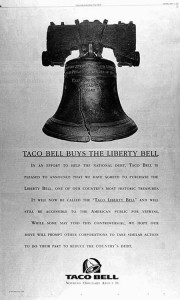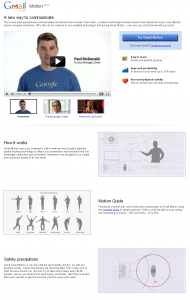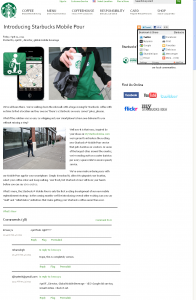Social Media Marketing: How to optimize the customer experience to benefit from word-of-mouth advertising
 Do you know the problem with the customer experience? It doesn’t have a media sales rep.
Do you know the problem with the customer experience? It doesn’t have a media sales rep.
So no one is taking you out to a nice lunch, plying you with semi-fine wine while slowly separating you from your budget and increasing your media spend on it.
However, that doesn’t mean that the customer experience doesn’t generate media for you. We live in a digital age where you must assume that every customer is also a publisher. So, if you invest in your customers, you can gain significant positive media exposure. Fail to invest? You can get significant exposure as well…it just won’t be as brand-friendly as those TV spots you just bought.
So, while businesses are expected to spend $214.3 billion on advertising in 2011(according to SNL Kagan), what return will they get for their investment? In recent research by Satmetrix, only four percent of Americans said they trust advertising the most as an information source when choosing products or services. The top choice? Independent sources (83 percent), especially those with whom they have personal relationships.
While recent research from Experian (warning: there is a squeeze page) disagrees on the exact number, it reaffirms the importance of winning over your customers. It states, “Despite consumer reliance on digital devices and Internet-provided information, the most influential element driving purchase decisions today is still word-of-mouth.”
Experian found that 54 percent of consumers chose word-of-mouth as highly influential to their purchase decisions. Of course, this shouldn’t be news to you. You probably learned about word-of-mouth in Marketing 101.
But, a lot has changed since then. As stated above, every customer you have is now likely a publisher as well. So now there is even word-of-mouth advertising from people your consumers have never even met. According to the Pew Internet & American Life Project, “nearly six-in-ten adults (58%) have done research online about the products and services they buy, and about a quarter (24%) have posted comments or reviews online about the things they buy.”
So, how do you optimize the customer experience to get the most from word-of-mouth advertising today?
There is no one right answer, of course. I asked around a little in this vast, resourceful marketing community of ours. Read on for a few tips, and I’d love to hear your thoughts as well…
Your customers can see right through your marketing so you might as well let them
“When a company is humble enough to admit a weakness, they immediately distinguish themselves from the competition. It opens the door for a trust relationship.
The consumer is all too aware of the fact that we are not perfect. To pretend otherwise only serves to raise their suspicion. Tell them what you can’t do, and they’ll believe you when you tell then what you can do.”
– Dr. Flint McGlaughlin, Managing Director (CEO), MECLABS
Transparent marketing is essential. According to the Satmetrix study, 20 percentof those who defected a company did so because of unfair fees or charges.
“Companies still need to advertise to create market awareness, but market trends such as the increased use of social media networks and consumer reviews online are all increasing transparency about the actual experiences that companies deliver, and what customers think of them,” John Abraham, general manager of Net Promoter programs at Satmetrix, said. “You just can’t hide any longer behind bad quality. Advertising and marketing messages need to line up with customers’ real experiences. So, first and foremost, you have to get the experience right.”
We’ll talk about getting that experience right in just a minute. But first, how do you ensure that your advertising and marketing messages are transparent and truly reflect what your customer is experiencing? You don’t want to be the Comical Ali of your company, claiming victory while the facts on the ground so clearly conflict with your messages. And while he may have literally had a gun to his head, forcing him to make ridiculous claims…you don’t. You have a choice.
As I’ve said before in these (Web) pages, I think Transparent Marketing: How to earn the trust of a skeptical consumer is an excellent guide, but, in full transparency, it is written by the man who signs my paychecks – Dr. Flint McGlaughlin.
So, I also wanted to get a perspective from someone outside of MECLABS and provide a very granular example that you could apply to your marketing efforts today. I asked Ryan Deutsch, VP of Strategic Services, StrongMail, about transparency in email marketing. He said that “welcome programs offer the best opportunity for transparency” and offered these specific tips:
- Provide examples of the types of messages the subscriber will be receiving
- Provide an overview of the frequency of communication and give the consumer the opportunity to set preferences around cadence
- Provide an explanation of how data is captured within the email program and how that is used to create more targeted and relevant messages
- Explain the privacy policy of the brand
- Explain the opt-out and unsubscribe options
Don’t dictate, discover
“It is the customer who determines what a business is. For it is the customer, and he alone, who through being willing to pay for a good or for a service, converts economic resources into wealth, things into goods. What the business thinks it produces is not of first importance – especially not to the future of the business and to its success. What the customer thinks he is buying, what he considers “value,” is decisive – it determines what a business is, what it produces and whether it will prosper.”
– Peter Drucker, The Practice of Management
In Peter Drucker’s day, it was far more difficult to determine what the customer considered valuable. Today, you have almost instant access to that information in many different ways:
- Test your value proposition – You can test and measure your value proposition in real-time under real-world conditions with your actual customers using PPC ads
- Actually ask your customers – Use automated exit surveys, ensure your sales and customer service teams track customer interactions in a CRM system, engage in one-on-one conversations in user forums, or use technology in some other creative way to pick your customers’ brains.
- Listen to what they say – Social media monitoring has become a very powerful tool to learning from your customers. Of course, don’t stop at listening to customers and discovering what they want, use social media to respond as well. For example…
I asked Joe Chernov, VP of Content Marketing, Eloqua how he uses social media to discover what customers want and nurture word-of-mouth advertising. As co-chair of the Word of Mouth Marketing Association’s Ethics Panel, he knows a thing or two about the topic. Here’s what he had to say…
“All customers are not created equal. Those who engage with you on social channels are far more likely to be your brand advocates. In fact, at Eloqua, a client who engages with us on any social network is 450 percent more likely to be a brand promoter than our baseline client. This self-selecting group is a collection of ambassadors-in-waiting. The key to unlocking their word-of-mouth is as simple as connecting with them on a personal level on their social channel of choice. That’s really all it takes.”
Truly serve your customers
“We learn whatever skills we need to service the customer. We build whatever technology we need to service the customer.”
– Jeff Bezos, CEO, Amazon
Think about Amazon for a moment. They mostly sell books and other stuff (lots of stuff) through an e-commerce store. Yet, out of seemingly nowhere, they launched their own hardware device – the Kindle. We take it for granted now, but for an e-commerce store to launch a hardware device in a segment that barely existed before it entered the market is quite revolutionary.
Why take that leap of faith? To truly serve the customer.
How can you truly serve your customers? After all, you’re likely not Jeff Bezos. You likely only have control over a small patch of territory in your overall company.
And yet, that patch is likely the tip of the spear in terms of customer interaction. You are in the unique position to discover and then shine a light on issues that really matter to your customers, to ensure that there is true value in your marketing propositions.
I asked Dave Ewart, Senior Director of Marketing, Satmetrix how marketers can achieve this. Satmetrix, the company behind the study referenced above, makes a management tool that can be used to gauge the loyalty of a firm’s customer relationships. Ewart said that successful customer-centric marketers:
- Continuously collect and analyze data about customer interactions and customer satisfaction, and they use automated customer listening and feedback systems;
- Track and measure word-of-mouth online, and identify and support customer advocates;
- Share data from customer interactions across organizational departments; this helps them strengthen relationships with customers and sometimes even uncovers untapped markets; and
- Lead a company-wide commitment to addressing and resolving customer issues and problems.
Don’t consider anything that impacts the customer “not my problem.” It’s you who made the promise upfront with your impressive marketing campaigns. So, it better be you who ensures that your company delivers on that promise with an exceptional customer experience.
If not, your customers hold the trump card. Advertising even more successful than yours. Word-of-mouth.
Related Resources
Hoax Marketing: Your brand comes first, humor second, even on April Fool’s Day
Social Media Marketing: Turning social media engagement into action at Threadless
The Last Blog Post: How to succeed in an era of transparent marketing
Inbound Marketing newsletter – Free Case Studies and How To Articles from MarketingSherpa’s reporters
Social Marketing ROAD Map Handbook
Photo attribution: hansvanrijnberk







 If you’re ever looking for an interesting marketing read (besides MarketingSherpa, of course!), check out
If you’re ever looking for an interesting marketing read (besides MarketingSherpa, of course!), check out 




